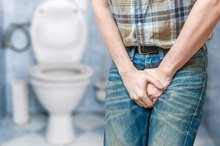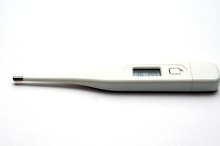What does fact checked mean?
At Healthfully, we strive to deliver objective content that is accurate and up-to-date. Our team periodically reviews articles in order to ensure content quality. The sources cited below consist of evidence from peer-reviewed journals, prominent medical organizations, academic associations, and government data.
The information contained on this site is for informational purposes only, and should not be used as a substitute for the advice of a professional health care provider. Please check with the appropriate physician regarding health questions and concerns. Although we strive to deliver accurate and up-to-date information, no guarantee to that effect is made.
Menopause & Bleeding Hemorrhoids
Menopause is the time in a woman’s life when menstruation comes to an end 2. Health professionals define menopause as 12 months after a woman’s last menstrual period.
Unfortunately menopause often comes with some unfavorable characteristics, one of which is hemorrhoids. Swelling and dilation around the veins of the anal region causes hemorrhoids. In some circumstances, hemorrhoids can bleed. Due to the increased susceptibility of developing hemorrhoids during menopause, women have a greater risk of experiencing bleeding hemorrhoids 124.
Causes
Although hemorrhoids can occur at any age, approximately 1/2 of all women will experience them by age 50, according to menopauserx.com, which is around the average age of menopausal onset in the United States.
A woman’s susceptibility to experiencing bleeding hemorrhoids during menopause can be increased from various conditions including prior childbirth, chronic constipation, prolonged sitting and the aging process, which includes going through menopause 124. One strong theory of the cause of hemorrhoids is varicose veins, which are also a result of the aging process.
Types
Causes of Brown Spotting 10 Days After Period
Learn More
There are two types of hemorrhoids: external and internal. It is the internal hemorrhoids that are the most common cause of bleeding 14. Internal hemorrhoids lie above the dentate line, which separates the anal canal from the rectum. They are typically painless except if the vein is disturbed during a bowel movement. Although they lie within the anal canal, they may develop inflammation and become enlarged enough to project through the anal opening.
Internal hemorrhoids also frequently leave individuals with a feeling that they did not completely empty their bowels during a bowel movement. External hemorrhoids, which lie below the dentate line, can result in extreme pain. Occasionally, a thrombosis--a blood clot formed by a dilated vein--can occur on the external hemorrhoid. When this occurs, the external hemorrhoid becomes hard and may be ulcerated to produce bleeding 4.
- There are two types of hemorrhoids: external and internal.
- External hemorrhoids, which lie below the dentate line, can result in extreme pain.
Symptoms
Symptoms vary depending on what type of hemorrhoid the woman has 4. Internal bleeding hemorrhoids are associated with rectal blood that appears bright red and leaves streaks on toilet paper during wiping and in the toilet bowl following a bowel movement 14. The stool may also have a bloody, mucus-like consistency. Internal bleeding hemorrhoids that become irritated and inflamed cause the feeling of having to pass stool even after a bowel movement has occurred 14. Common symptoms of external bleeding hemorrhoids include severe pain and blood stains in the underwear 14.
Treatment
What Causes Blood Clots in Stools?
Learn More
Treatment for bleeding hemorrhoids during menopause varies 14. Suppositories, creams, natural remedies and surgery are all treatment options.
A large selection of creams can be purchased over the counter to be used on external bleeding hemorrhoids 14. Suppositories are used for internal bleeding hemorrhoids but typically only treat pain and itching, not bleeding 14. Some women decide to use natural remedies such as topical herbs. On average, natural methods take longer to be effective but are just as successful as other treatment methods. Excessive hemorrhoid bleeding may require surgical methods of treatment 4. Banding is the most popular surgical technique. In this method, a rubber band is used to tie off the affected vein, thus preventing the blood supply from reaching it. Without adequate blood supply, the hemorrhoid will shrink and die. Another popular surgical technique is laser surgery. In this method, the vein is cauterized to avert the flow of blood to the hemorrhoid.
- Treatment for bleeding hemorrhoids during menopause varies 1.
- In this method, a rubber band is used to tie off the affected vein, thus preventing the blood supply from reaching it.
A Common Mistake
During the beginning of menopause and before the complete cessation of the menstrual period, many women experience sporadic menstrual bleeding 2. This often results in mistaking hemorrhoidal bleeding for menstrual bleeding.
It is imperative for all women to know where their bleeding is coming from to recognize the existence of bleeding hemorrhoids [1](http://www.bleedinghemorrhoids.net/do-you-have-a-hemorrhoid-bleeding/ 'inline-reference::Bleeding Hemorrhoids: Do You Have A Hemorrhoid Bleeding?
')4.
Whereas menstrual bleeding comes from the vagina, blood from hemorrhoids comes from the anal canal 14. There are still many other possible causes of bleeding during menopause, some of which can be life-threatening. In any circumstance, a woman should visit her doctor if she is experiencing bleeding of any kind.
- During the beginning of menopause and before the complete cessation of the menstrual period, many women experience sporadic menstrual bleeding 2.
Related Articles
References
- The Mayo Clinic: Menopause
- Menopause Rx: GI Disorders
- Harvard Medical School. Hemorrhoids and what to do about them. Harvard Health Publishing. Updated February 6, 2019.
- National Institute of Diabetes and Digestive and Kidney Diseases. Symptoms & Causes of Hemorrhoids. Published October 2016.
- Lohsiriwat V. Treatment of hemorrhoids: A coloproctologist's view. World J Gastroenterol. 2015;21(31):9245-52. doi:10.3748/wjg.v21.i31.9245
- National Institute of Diabetes and Digestive and Kidney Diseases. Definition & Facts of Hemorrhoids. Published October 2016.
- Ibrahim AM, Hackford AW, Lee YM, Cave DR. Hemorrhoids can be a source of obscure gastrointestinal bleeding that requires transfusion: report of five patients. Dis Colon Rectum. 2008;51:1292-4. doi:10.1007/s10350-008-9376-3
- Lorber BW. Thrombosed External Hemorrhoid Excision. Medscape. Updated August 17, 2018.
- Sanchez C, Chinn BT. Hemorrhoids. Clinics in Colon and Rectal Surgery. 2011;24:5-13. doi:10.1055/s-0031-1272818





